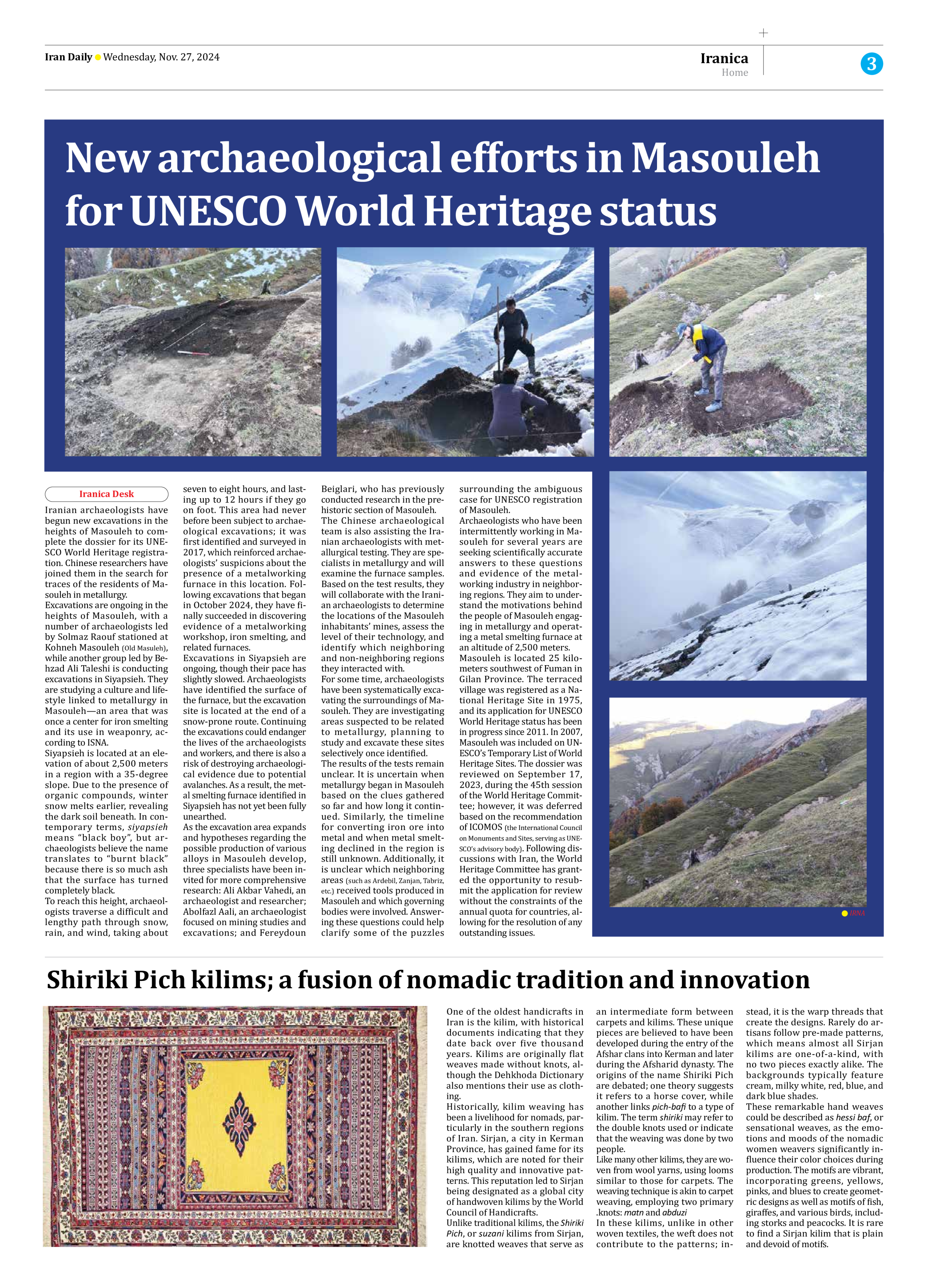
New archaeological efforts in Masouleh for UNESCO World Heritage status
Iranian archaeologists have begun new excavations in the heights of Masouleh to complete the dossier for its UNESCO World Heritage registration. Chinese researchers have joined them in the search for traces of the residents of Masouleh in metallurgy.
Excavations are ongoing in the heights of Masouleh, with a number of archaeologists led by Solmaz Raouf stationed at Kohneh Masouleh (Old Masuleh), while another group led by Behzad Ali Taleshi is conducting excavations in Siyapsieh. They are studying a culture and lifestyle linked to metallurgy in Masouleh—an area that was once a center for iron smelting and its use in weaponry, according to ISNA.
Siyapsieh is located at an elevation of about 2,500 meters in a region with a 35-degree slope. Due to the presence of organic compounds, winter snow melts earlier, revealing the dark soil beneath. In contemporary terms, siyapsieh means “black boy”, but archaeologists believe the name translates to “burnt black” because there is so much ash that the surface has turned completely black.
To reach this height, archaeologists traverse a difficult and lengthy path through snow, rain, and wind, taking about seven to eight hours, and lasting up to 12 hours if they go on foot. This area had never before been subject to archaeological excavations; it was first identified and surveyed in 2017, which reinforced archaeologists’ suspicions about the presence of a metalworking furnace in this location. Following excavations that began in October 2024, they have finally succeeded in discovering evidence of a metalworking workshop, iron smelting, and related furnaces.
Excavations in Siyapsieh are ongoing, though their pace has slightly slowed. Archaeologists have identified the surface of the furnace, but the excavation site is located at the end of a snow-prone route. Continuing the excavations could endanger the lives of the archaeologists and workers, and there is also a risk of destroying archaeological evidence due to potential avalanches. As a result, the metal smelting furnace identified in Siyapsieh has not yet been fully unearthed.
As the excavation area expands and hypotheses regarding the possible production of various alloys in Masouleh develop, three specialists have been invited for more comprehensive research: Ali Akbar Vahedi, an archaeologist and researcher; Abolfazl Aali, an archaeologist focused on mining studies and excavations; and Fereydoun Beiglari, who has previously conducted research in the prehistoric section of Masouleh.
The Chinese archaeological team is also assisting the Iranian archaeologists with metallurgical testing. They are specialists in metallurgy and will examine the furnace samples. Based on the test results, they will collaborate with the Iranian archaeologists to determine the locations of the Masouleh inhabitants’ mines, assess the level of their technology, and identify which neighboring and non-neighboring regions they interacted with.
For some time, archaeologists have been systematically excavating the surroundings of Masouleh. They are investigating areas suspected to be related to metallurgy, planning to study and excavate these sites selectively once identified.
The results of the tests remain unclear. It is uncertain when metallurgy began in Masouleh based on the clues gathered so far and how long it continued. Similarly, the timeline for converting iron ore into metal and when metal smelting declined in the region is still unknown. Additionally, it is unclear which neighboring areas (such as Ardebil, Zanjan, Tabriz, etc.) received tools produced in Masouleh and which governing bodies were involved. Answering these questions could help clarify some of the puzzles surrounding the ambiguous case for UNESCO registration of Masouleh.
Archaeologists who have been intermittently working in Masouleh for several years are seeking scientifically accurate answers to these questions and evidence of the metalworking industry in neighboring regions. They aim to understand the motivations behind the people of Masouleh engaging in metallurgy and operating a metal smelting furnace at an altitude of 2,500 meters.
Masouleh is located 25 kilometers southwest of Fuman in Gilan Province. The terraced village was registered as a National Heritage Site in 1975, and its application for UNESCO World Heritage status has been in progress since 2011. In 2007, Masouleh was included on UNESCO’s Temporary List of World Heritage Sites. The dossier was reviewed on September 17, 2023, during the 45th session of the World Heritage Committee; however, it was deferred based on the recommendation of ICOMOS (the International Council on Monuments and Sites, serving as UNESCO’s advisory body). Following discussions with Iran, the World Heritage Committee has granted the opportunity to resubmit the application for review without the constraints of the annual quota for countries, allowing for the resolution of any outstanding issues.







